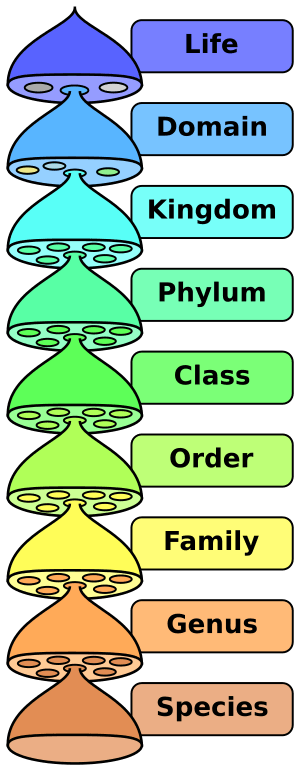Biological classification facts for kids
Biological classification is how biologists sort and group all the different living things on Earth. Think of it like organizing your toys or books into different categories. Scientists do this with organisms to understand them better.
This way of grouping started a long time ago with people like Aristotle. But a very important person was Carl Linnaeus. He came up with a super useful system called binomial nomenclature. This means every species gets a two-part name. For example, humans are called Homo sapiens. The first part is the genus, and the second part is the species. These names are often written in italics.
Biological classification is also called taxonomy. It's a science that changes as we learn more. Today, scientists try to group organisms based on evolution. This means they look for shared ancestors. Modern studies often use DNA to see how closely related organisms are. This helps create an evolutionary "tree of life". It shows how different species are connected through history.
Contents
Why We Group Living Things
Grouping living things helps us understand how they are related. It also helps us study them more easily. When organisms are in the same group, they often share similar features. This similarity usually comes from having a common ancestor.
Homologous Traits
Sometimes, different animals have similar features because they inherited them from a shared ancestor. These are called homologous traits. For example, both bats and whales are mammals. They both feed their young milk. This is a homologous trait because it came from their common mammal ancestor.
It's important to know the difference between homologous traits and analogous traits. Analogous traits are similar features that developed separately. For instance, both birds and bats can fly. But they didn't get the ability to fly from the same ancestor. So, flight in birds and bats is an analogous trait, not a homologous one.
Naming Rules
When the system for naming living things was first made, Latin was a language many scientists used. So, scientific names are still in Latin. This helps scientists all over the world understand each other.
For new animal species, descriptions can be written in any language. But for new algae, fungi, and plants, descriptions must be in English or Latin since 2012.
How Names End
Groups above the genus level often have names that end in a specific way. These endings depend on the kingdom the organism belongs to. They also depend on its phylum or class. This table shows some common endings:
| Rank | Plants | Algae | Fungi | Animals |
|---|---|---|---|---|
| Division/Phylum | -phyta | -mycota | ||
| Subdivision/Subphylum | -phytina | -mycotina | ||
| Class | -opsida | -phyceae | -mycetes | |
| Subclass | -idae [sic] | -phycidae | -mycetidae | |
| Superorder | -anae | |||
| Order | -ales | |||
| Suborder | -ineae | |||
| Infraorder | -aria | |||
| Superfamily | -acea | -oidea | ||
| Family | -aceae | -idae [sic] | ||
| Subfamily | -oideae | -inae | ||
| Tribe/Infrafamily | -eae | -ini | ||
| Subtribe | -inae | -ina | ||
See also
Images for kids
-
Description of rare animals (写生珍禽图), by Song dynasty painter Huang Quan (903–965)
-
Title page of Systema Naturae, Leiden, 1735
-
Evolution of the vertebrates at class level. The width shows the number of families.
-
The same relationship, shown as a cladogram.
-
Type specimen for Nepenthes smilesii, a tropical pitcher plant.
 In Spanish: Taxonomía para niños
In Spanish: Taxonomía para niños







